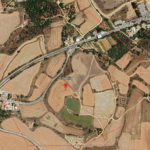I chose Strovilia not only for my personal connection to it but also for its fascinating and largely untold historical narrative. Its legacy, while significant, has remained hidden, making the process of uncovering its history both challenging and rewarding.
During my stay in Cyprus, I realized just how little tangible information I had about Strovilia’s historical timeline. I had grown up hearing stories that it was once a royal village, but I didn’t know when or how this came to be, and neither did anyone I asked. Determined to find answers, I unearthed literature from the overlooked archives of the Famagusta Cultural Center in Deryneia. This process uncovered historical facts that completely changed my perspective on the project. I discovered that Strovilia was a thriving settlement as early as the Byzantine period, prospered under the Frankish rule as Casal de Strovili, and was part of the administrative unit Bailages de Sotira. The Mamluk raids of 1425 devastated the village, initiating a decline that saw it nearly abandoned by the Ottoman period.
What struck me most was the role of the Church of Saint Nicholas, which remained a focal point for the community even during times of hardship. Once in ruins, the church was gradually restored in the early 1900s through the efforts of local families, including some of my own ancestors. These acts of preservation embody the idea of Living Heritage, where the ongoing care for cultural sites and tradition fosters not only continuity but also resilience. The church represents more than a building, it is a communal space that ties people to their cultural past, even as geopolitical tensions and colonial legacies have shaped the village’s fate.
Reflecting on this research has not only deepened my understanding of Strovilia’s history but has also further solidified my project’s direction. Initially, I worried that Strovilia might not be a suitable case study for the Futures Project due to its small scale and obscurity. However, discovering these layers of history and their connection to broader themes of conflict, colonialism, and cultural resilience has reaffirmed the village’s relevance. Moving forward, I aim to explore how contested spaces like Strovilia can preserve intangible cultural heritage through communal sites and living practices, despite political and social upheaval.
This history matters to me on both a personal and academic level. Strovilia represents a microcosm of the challenges faced by communities in contested spaces all over the world and offers valuable lessons about resilience, identity, and the preservation of cultural memory.
C.C.
Bibliography
Knaïs, G.I., 2005. Deryneia and its Neighbors: Natural and Cultural Heritage. 2nd ed. Larnaca: MasterPrint. ISBN: 9963-8131-1-9.


